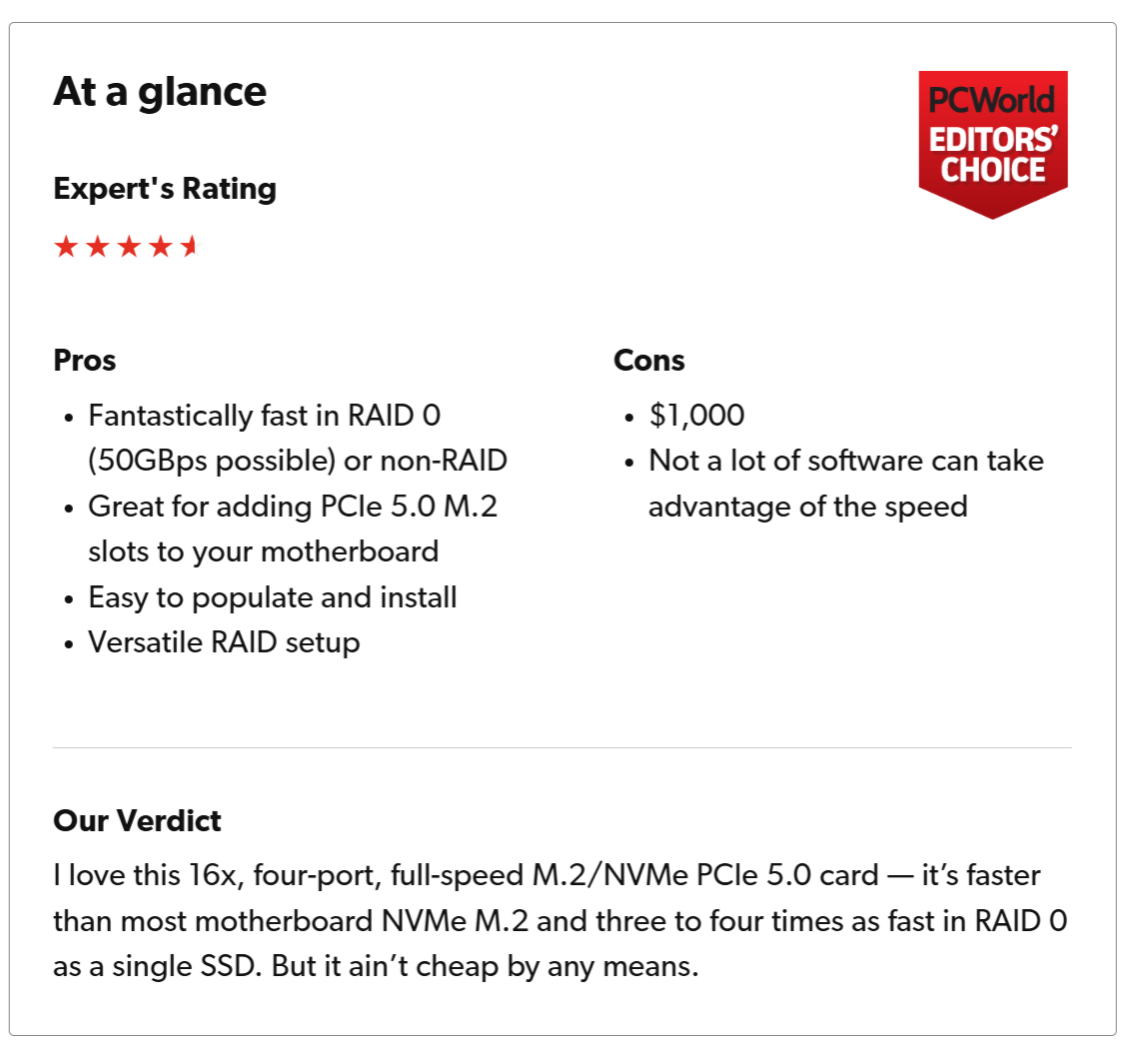HighPoint 7604A RAID card review: Up to 32TB of blisteringly-fast storage
Want 50GBps of sequential data transfer performance? This x16 PCIe 5.0 NVMe RAID card sporting four full-speed M.2 slots can deliver it -- for a rather hefty amount of coin.

By Jon Jacobi
Contributor, PCWorld

Image: Jon L. Jacobi

Best Prices Today: HighPoint 7604A RAID card
If you want up to 32TB of lightning-fast storage, there’s no better way to get it than HighPoint’s 7604A — a four-slot, PCIe 5.0 x16, NVMe expansion card. It can transfer data as fast as 50GBps in RAID 0, and is also a great way to up your count of PCIe 5.0 M.2 slots from the single slot provided by most motherboards.
But you need software that does direct I/O to take advantage of the RAID performance and the 7604A is pricey — this puppy will set you back a cool $1,000. If you find that scary, it was listed at an astronomical $2,000 when I started this review. Fortunately, the company came back to low earth orbit, but it’s still not what most people would consider an impulse buy.
What are the 7604A’s features?
As already discussed, the 7406A is a PCIe 5.0 x16 card with four x4 NVMe M.2 slots on board. With each slot allotted four lanes, you get top bandwidth out of every SSD on the card, unlike many cheaper cards where four or eight lanes are divvied up.
In theory, throughput can be as high as 56GBps in RAID 0. Depending on your system, the 7604A can get close to that. Yowser!

The 7602A populated with a rag-tag assortment of PCIe 5.0 SSDs. It performed better when I matched the WD SN8100s with a Crucial T705 pair.
As you can see above (and below with the heatsink/fan on), the 7604A is of quality construction. Not shown are the status LEDs on the endplate. These provide feedback on the state of the card. The 7640A will also yelp (a loud beep) at you if you try to use it without the heatsink/fan. You can guess how I acquired that particular piece of knowledge.

This is a beefy heatsink with a very effective, but somewhat noisy fan that kicks in under stress.
The 7604A can function as four individual full-bandwidth x4 PCIe 5.0 M.2 slots, or in various RAID modes (0, 1, 5, 10). The RAID is hardware, but also dependent upon HighPoint’s driver, as well as the company’s configuration and monitoring software. I.e., there are no dip switches or jumpers.

The browser-based 7604A configuration and monitoring software. This is the information on the actual adapter and it’s connection speed.
The driver was rock solid and the configuration software works quite well. The admin interface is HTML-based — i.e., it opens in your web browser, and is slightly slow to respond to commands. It also gave me a can’t-connect error requiring a couple of reloads before the interface would appear. Communications lag, no doubt.
The configuration interface is also a bit geeky in language and concepts, so if you don’t know about RAID, bone up on the concepts before attempting to create an array or otherwise configure the card.
Note that neither the driver or configuration software are required if you simply want to add four x4 M.2 NVMe ports to your system. Slap the populated 7604A into an x16 PCIe 5.0 slot and the drives will simply appear under disk management, where you may in initialize and format the drives appropriately.
How does the 7604A perform?
While I did not get the numbers that HighPoint says are possible, they were still pretty darn good on our new test bed. You can read about the new test bed at the bottom of this article.
Of course, to get top performance out of the 7604A, two things must happen: It must be populated with PCIe 5.0 NVMe SSDs and it must be in a 16x PCIe 5.0 slot and actually connecting with 16 lanes and at 32GT/s. This can be an issue with some motherboards and CPUs, so check the number of lanes you have and how your motherboard allocates them (bifurcation).
I populated the 7604A with two Crucial T705 and two WD Black SN8100 2TB SSDs for testing — among the very fastest of their PCIe 5.0 ilk. The single SSD test was with a WD Black SN8100.
Note that the single-queue performance is what you’ll see from Windows Explorer transfers (theoretically, real life is much different) and most software, while the multi-queue performance is what you’ll see from software that does its own I/O. Regardless, 44.3GBps is a fun number.
Even without the software to leverage the 50GBps RAID 0, having an additional four full-speed PCI 5.0 NVME slots is awfully enticing.

No matter which way you cut it, the 7604A is hauling the freight when it comes to sequential throughput. Longer bars are better.
The 7604A’s CrystalDiskMark 8 random test results highlight the facts that RAID 0 is not particularly good for random access, and that the 7604A is also a very good host for individual drive performance.

This test highlights the fact that RAID 0 is not particularly good for random access, and that the 7604A is a very good platform or single drive performance. Longer bars are better.
What is apparent from the next charts is that you’re not going to see vast improvements with the naked eye when it comes to Windows file transfers. Note that we have changed this test to include DiskBench (DB) and Xcopy (XC) alongside our traditional Windows Explorer drag-and-drop (bottom of the chart).
Xcopy is significantly faster than the Windows Explorer drag-and-drop, which raises the question: Why would Microsoft optimize a command line program while leaving Windows Explorer comparatively slow as molasses?
Xcopy might be worth learning and using if you more than occasionally have a lot of data to copy. Big hint: batch files (x.bat).

Real-world performance in Windows transfers doesn’t show the improvement you will get with the proper software. Shorter bars are better.
The 7604A turned in good numbers in our 450GB write test in RAID 0; however, it was actually faster with a single drive in this test according to the quicker Xcopy and FastCopy. If you want fast file transfers within Windows Explorer, take the latter for a test ride.

The 7604A turned in good numbers in our 450GB write test in RAID 0, however, it was actually faster with a single drive in this test in some instances. Shorter bars are better.
The 7604A was considerably faster with single drives than our Z890 test bed motherboard’s M.2 slots — a known issue with the chipset, NVMe, and certain processors such as our i5 Core Ultra 225.
In RAID 0, the 7604A will be a boon for any software that can’t take advantage of it. That means any software using multi-queue, multi-thread disk I/O. Such software is rare in the consumer market, but not unheard of.
Caveat: If you are a fan of extreme peace and quiet, be warned that the 7604A’s fan kicks in quite a bit when it’s under stress, and it’s not particularly bashful. Just saying.
Should you buy the HighPoint 7604A?
I love the 7604A and it’s a fantastic performer. Would I pay $1,000 for it? Yes, if I had the need and the software to take full advantage. Even without the software to leverage the 50GBps RAID 0, having an additional four full-speed PCI 5.0 NVME slots is awfully enticing.
For the average user, though, which includes me — the 7604A is a tough recommend as the real-world benefits in everyday usage don’t quite add up to $1,000 in my estimation.
But that is absolutely not a knock on the 7604A as a product. As I said, it’s a fantastic piece of kit. Nice job, HighPoint.
How we test
Drive tests currently utilize Windows 11 24H2, 64-bit running off of a PCIe 4.0 Samsung 990 Pro in an Asus Z890-Creator WiFi (PCIe 4.0/5.0) motherboard. The CPU is a Core Ultra i5 225 feeding/fed by two Kingston Fury 32GB DDR5 4800MHz modules (64GB of memory total). Both 20Gbps USB and Thunderbolt 5 are integrated and Intel CPU/GPU graphics are used. SSDs involved in the test are mounted in a HighPoint 7604A 16x PCIe 5.0 adapter card. (Yes, the subject of this review)
We run the CrystalDiskMark 8, AS SSD 2, and ATTO 4 synthetic benchmarks to find the storage device’s potential performance, then a series of 48GB and 450GB transfers tests using Windows Explorer drag and drop to show what you’ll see under Window, as well as the far faster Xcopy to show what’s possible.
The 48GB transfer tests utilize an USFMount RAM disk taking up 58GB of the 64GB of total memory. The 450GB file is transferred from an SSD on the HighPoint card.
.png)
